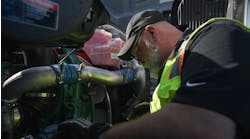Every fleet has a mission or purpose. In their mission statement, UPS notes the goals of “…serving the logistics needs of customers, offering excellence and value…." A to Z Express Delivery, a delivery service in Austin, Texas, wants “…to provide our customers with the most professional, fast, dependable, and technologically advanced delivery service in Austin and its surrounding areas.”
These statements drive the most critical activities of the organization. By picking the mission apart, you can see what would support and achieve it. With UPS, the focus is on measuring the achievement of excellence and value for the customers. The Austin delivery service emphasizes fast and dependable services. The search for key performance indicators (KPIs) will use these statements to find out what to measure for success.
Measuring KPIs could be compared to a waterfall, where the KPIs cascade down through the layers of the organization. Each level in the company has its own KPIs in a direct line to support the mission determined by the founders or top bosses.
The search for impactful KPIs starts at the highest level in the organization. To start the search, determine which two or three metrics will directly lead to the organization's success. With profit-making fleets like UPS, for example, the mission is to provide excellence and value. To provide value, the fleet needs controlled costs such as cost per parcel delivered; for heavy freight, this would be cost per ton/mile. Both metrics may tell much of the story. Other KPIs that lead to success might include percentage of on-time deliveries.
Two fundamental types of metrics
There are two types of metrics for managing any enterprise, known as lagging indicators and leading indicators.
Lagging indicators: Lagging KPIs measure goal accomplishment. These metrics are easy to measure but difficult to change. There is no opening for action, for example, if a person weighs 247 lbs and their goal is to weigh 220 lbs. There is nothing to tell them what to do.
In maintenance, lagging indicators can be metrics such as mean time to repair (MTTR), overall equipment effectiveness (OEE), and mean time between failures (MTBF).
Leading indicators: Leading KPIs measure goal achievement. They are used to predict changes or trends and they are forward-looking to help manage the performance of a system or process. Leading indicators can be influenced, but they can be challenging to find. If a person weighs 247 lbs and they want to weigh 220 lbs, a leading indicator might be calories consumed. The opening for action is to eat fewer calories.
If a fleet wants to improve reliability, the lagging indicator is downtime and the leading indicator might be preventive maintenance (PM) compliance. If the fleet wants a smooth-running shop, it may be helpful to consider schedule compliance as a leading indicator.
Context
KPIs can be strange in that they might be a leading indicator in one context and a lagging indicator in another. For example, weight is a leading indicator of health. To achieve better health, a person should move towards their optimal weight.
While there can be many performance indicators (PIs), there should only be two or three KPIs. A fleet should look to its mission for measures that, if achieved, would mean success for the company.
Follow the waterfall to your level of the organization and see which measures under your scope of control would help achieve the institution's goals. The objective is an organization where everyone is pulling in the same direction toward the achievement of the mission.
Joel Levitt is the president of Springfield Resources, a management consulting firm that services a variety of clients on a wide range of maintenance issues. Levitt has trained more than 17,000 maintenance leaders from more than 3,000 organizations in 38 countries. He is also the creator of Laser-Focused Training, a flexible training program that provides specific, targeted training on your schedule, online to one to 250 people in maintenance management, asset management, and reliability.




